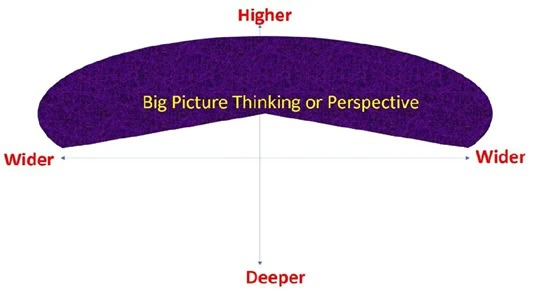Article Contents:
What is meant by " Big Picture Thinking?"
One of the qualities of competent people is the ability to have “big-picture thinking or perspective” in any circumstance.
Big picture thinking in a professional context refers to the ability to see and understand the situation or issues or challenges or opportunities in a broader context.
It is the ability to look at the situation context and its implications, consequences of actions, decisions, and strategies within an organization or industry.
A big-picture perspective is looking at any interaction event or opportunity from a higher, broader angle view to get a holistic idea rather than immediately getting into details.
For instance, when faced with a complex project, a big-picture thinker would first consider the overall goals, resources, and potential obstacles, before diving into the specific tasks and timelines.
Examples -" Big Picture Thinking"

For example, when you fly over your city on a flight, you can view the entire city. You may be able to see high-rise buildings, rivers, roads, flyovers, and so on. This holistic view is possible only when you are at an elevated level, say, at higher feet from the ground.
Similarly, in personal and professional life, when you look at any events, incidences, conversations from a higher-level view, you will get a holistic idea about opportunities, growth potentials, and other benefits.
The key is elevating yourself at a higher level or distancing yourself emotionally and look at the things.
For instance, in a business setting, a big-picture thinker might consider the long-term impact of a decision on the company’s reputation rather than just the immediate financial gain.
Suppose your boss is asking you to take additional responsibility as being aware of your potential. If you are a big-picture-thinking person, you will immediately be thinking about learning opportunities, future growth prospects, exposure, etc.
Otherwise, immediately, you will be worrying too much about the unfamiliarity of the job and refuse to accept or get into a conversation on monetary benefits, working hours flexibility, and so on.
The main idea is not to delve into the specifics, but rather to comprehend how you distance yourself emotionally. When you elevate yourself to a higher and wider level, you gain a holistic view.
This comprehensive perspective allows your mind to tackle any challenges on a micro-level. Adopting this mindset is crucial for personal growth and development.
Why one should develop " Big picture thinking" competency?
Strategic Planning: Big picture thinking enables individuals to contribute to strategic planning processes by understanding how their specific roles fit into the larger objectives of the organization. This helps in aligning individual efforts with overall business goals.
Problem-Solving: When faced with challenges or obstacles, individuals who can think big picture are better equipped to analyze root causes and identify comprehensive solutions that address underlying issues rather than just addressing symptoms.
Adaptability: In a constantly evolving business environment, those who can think big picture are more adaptable to change. They can anticipate shifts in market dynamics, technological advancements and proactively adjust strategies accordingly.
Leadership Skills: Developing big picture thinking is essential for effective leadership. Leaders who can articulate a compelling vision for the future and inspire others to work towards common goals are more likely to drive organizational success.
Communication and Collaboration: Big picture thinkers are better communicators and collaborators. They can convey complex concepts in simple terms, facilitate discussions across departments or teams, and foster collaboration by helping others understand how their contributions impact the overall objectives.
Overall, cultivating big picture thinking is significant for personal and professional growth.
How one can develop big picture thinking at personal level?
Having discussed the definition of big picture thinking and its benefits on growth, it is important to understand how to develop this skill at personal level and organization level.
Once, three people were working on a bridge construction project.
A stranger approached the first person and asked what he was doing. The person replied, “Can’t you see that I am laying stones.”
The stranger then moved on to the second person and asked the same question. The second person replied, “I am working on my income to take care of myself and my family.”
Finally, the stranger approached the third person and asked him what he was doing. The third person replied with a smile, “I am building a bridge. Once the construction is complete, many people will pass over this bridge. I am helping others to move fast. This bridge will be here centuries after I leave.”
The story has a powerful message about how looking at your work with a higher purpose can make a difference in the quality of work and life. This is big-picture thinking.
It involves extending our perspective or thinking beyond working for survival and towards a higher purpose.

For example,
if you are a professional, how do you envision your profession in the next 5-10 years?
If you run a business, how do you see your product/service impacting the market 10-20 years from now?
If you look at your profession only as a means for survival, that is low-order level thinking. But if you extend your thinking to consider the impact you can create through your job or business, you are engaging in high-order or big-picture thinking.
When proposing ideas to your team, if they don’t receive them well, you may think they are resisting. This is low-order thinking or micro-level thinking.
Big-picture thinking involves considering other factors that may be contributing to the resistance, such as the need for more explanation, poor communication skills, or poor timing. In this process, you must look at the event from 360 angles.
The key to big-picture thinking is how you extend your thinking process from small to larger, broader, and 360-degree angles.
This skill can be learned and developed at any age with awareness and practice.
How can you inculcate Big picture Thinking at team level in the organization?
After discussing how to develop big-picture thinking at an individual level, it’s time to understand how smart leaders teach big-picture thinking to their team members.
I have observed some leaders and their methods of developing big-picture thinking in their organization among team members.
The following are the methods I have observed:
- Share the big-picture perspective frequently with the team.
- Brief the context while delegating tasks.
- Help the team to see the meaning in their work.
Let me explain each of these methods in detail.
- Sharing the big picture frequently with the team:
One CEO of a social organization shares the prime purpose of the organization, “Making a positive impact,” with his team members frequently during meetings.
Eventually the team members also articulate the same purpose and align their behavior with the big-picture perspective during any business transaction with customers and stakeholders.
- Briefing the context when delegating the task:
Rather than giving a to-do list, effective leaders delegate responsibility and brief the person about the context of the job.
For instance, instead of merely asking a salesperson to prepare the next three months’ sales projection, leaders can explain the context of sales projection to manage plant capacity, mobilize the working capital, and more.
This makes the person more careful about the accuracy of the sales projection, allowing them to understand the big picture.
- Helping the team to see the meaning of their work:
When an individual understands the meaning of their work, it enhances their big-picture thinking and contribution. Since teams are organized by department or function, the thought process is usually confined to a functional perspective.
Leaders should remind individuals or teams how their work aligns with organizational objectives or how it helps customers.
Macro management vs Micro detailing
We have discussed importance of having both big-picture thinking and micro-detailing skills in order to develop oneself and the team. However, we didn’t discuss when it’s best to use each style.
Should leaders prioritize big-picture thinking or micro-detailing?
How can they switch between the two effectively?
There is no one-size-fits-all answer to these questions.
Everyone should have both skills, and it is important to know when to use each one based on the situation.
Balancing both styles is essential, as it is not always best to be in an extreme state. We should prioritize the larger interests of others over our own.
Effective people are aware of themselves and their abilities to switch between big-picture thinking and micro-detailing. They add value to others and the organization in both states. It comes by awareness and practice. That means any one can develop with efforts.
For example,
I once worked with a senior colleague who was known for his big-picture thinking and visionary approach. However, during a period of high demand for our products, the team faced delivery issues due to supply chain problems.
He shifted his focus to the micro-level and helped the team manage the crisis. At the same time, he also thought about long-term solutions to the problem.
After the crisis was resolved, he took steps to prevent it from happening again.
He was able to switch between big-picture and micro-level thinking when necessary, and solved the problem permanently.
As business managers or leaders, it is essential to develop the ability to switch between big-picture and micro-detailing.
This capability will help sustain growth and benefit the organization as a whole.
My personal analysis on Big picture vs micro detailing on organizational performance
I have had the opportunity to work with over 100 small business leaders, and I conducted research on their leadership styles – whether they focused on the big picture or micromanaged.
Only 47% of the sample demonstrated the ability to do both during the intervention. Interestingly, there is a positive correlation between business leaders who can switch between the two styles and consistent growth in the organization over the past 5 to 8 years.
Meanwhile, 41% of business leaders demonstrated a higher level of big-picture thinking and lacked attention to detail on day-to-day issues.
These organizations struggled with consistent growth, some even becoming stagnant or switching to other businesses. Similarly, the 12% of business leaders who demonstrated high levels of micro-management also lost sight of growth opportunities.
I am aware that many variables influence the growth or stagnation of a business, and I am not concluding that leadership capability alone contributes to growth. However, it is also a contributing factor.
We need to conduct more research on this aspect.



